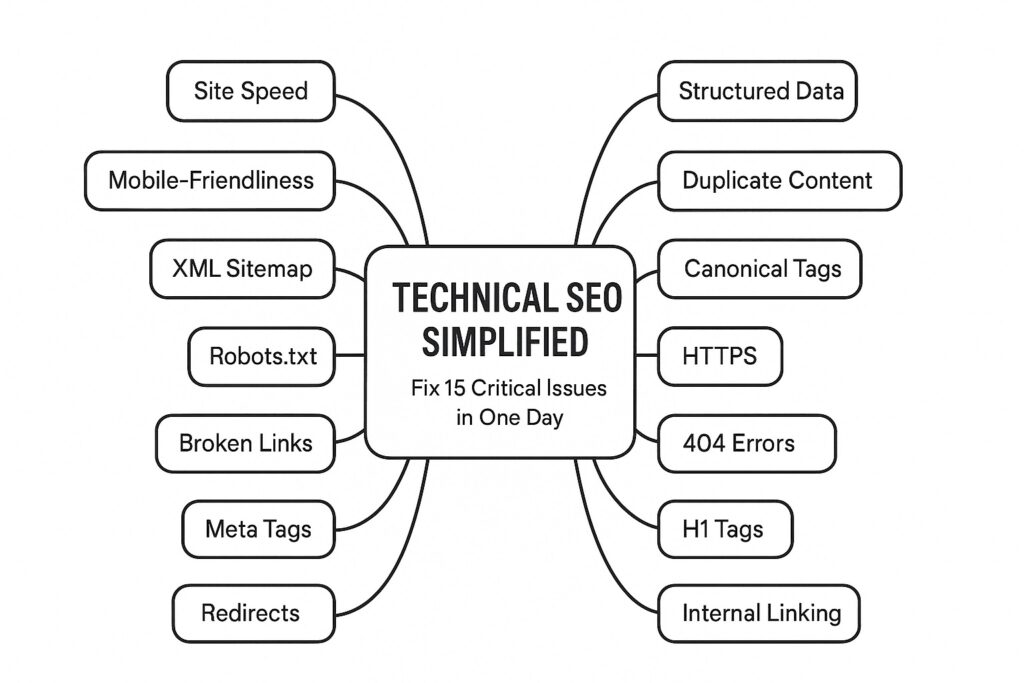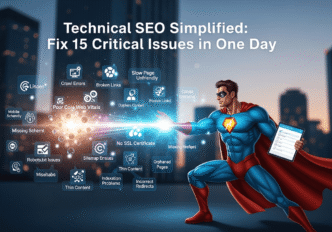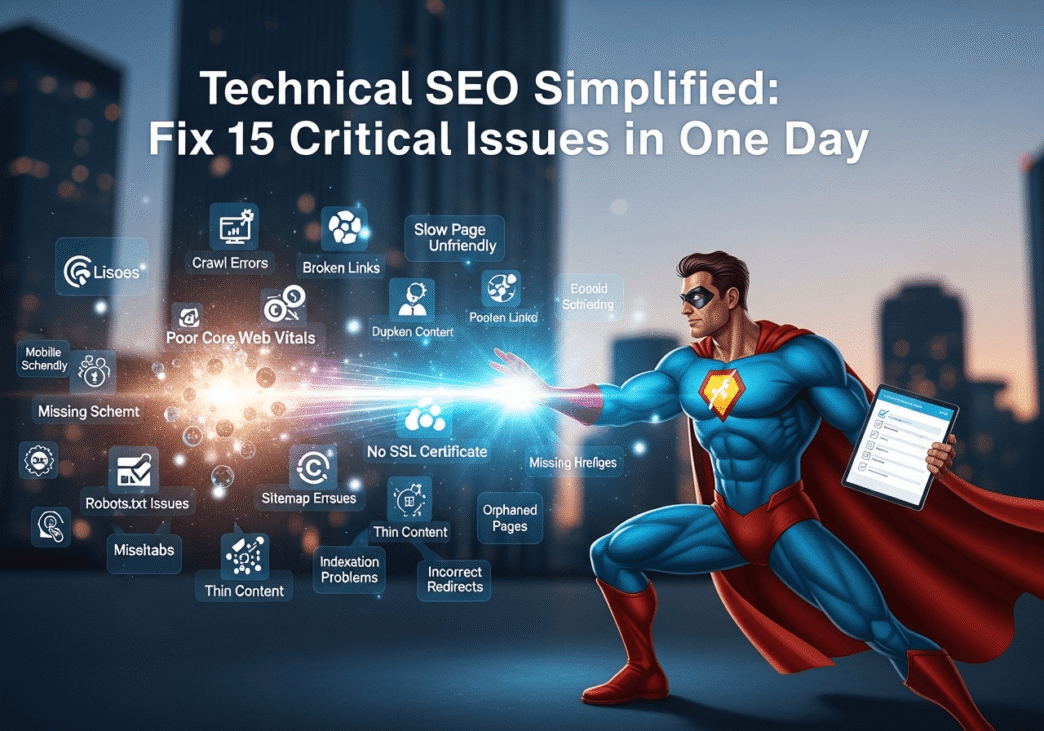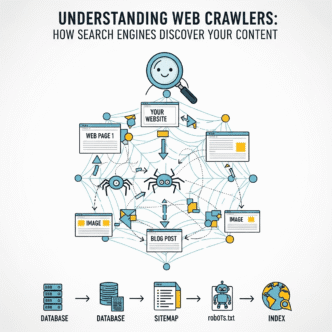Table of Contents
ToggleThe Complete Guide to Technical SEO Mastery
Your website looks amazing. Your content is top-notch. Your marketing budget is working overtime. But your rankings? They’re stuck in SEO purgatory, and you have no idea why.
Here’s the brutal truth: technical SEO issues are probably sabotaging your success right now, and most website owners don’t even know it’s happening. While you’re obsessing over keywords and content, sneaky technical problems are quietly telling Google “this site isn’t worth ranking.”
The good news? Most technical SEO issues can be diagnosed and fixed in a single day. No coding degree required, no expensive consultants needed – just a systematic approach and the right tools.
This comprehensive guide will transform your technically troubled website into a search engine powerhouse, one fix at a time. Whether you’re a beginner or seasoned marketer, this pillar resource covers everything you need to master technical SEO in 2025.
SEO Issues and Why Should You Care?
Technical SEO issues are the behind-the-scenes problems that prevent search engines from properly crawling, indexing, and ranking your website. Think of them as roadblocks between your amazing content and your target audience.
Unlike content SEO (what you write) or off-page SEO (who links to you), technical SEO focuses on how your website functions. It’s the foundation that everything else is built on.
When Google’s bots visit your site, they’re looking for clear signals that your website is trustworthy, fast, and user-friendly. Technical optimization ensures those signals are loud and clear.
Why Do Technical SEO Problems Kill Your Rankings?
Search engines are essentially lazy. They want to crawl and index your content with minimal effort. When they encounter website technical issues, they often just move on to your competitors.
Google has stated that site performance is a direct ranking factor. Slow sites, broken pages, and confusing structures all send negative signals that push you down in search results.
The most frustrating part? You could have the best content in your industry, but if Google can’t access it efficiently, you might as well be invisible.
Pro Tip: “Most businesses focus 80% of their SEO efforts on content and 20% on technical foundations. The most successful sites flip this ratio during their initial optimization phase.” – Senior Technical SEO Consultant
How Can You Identify Technical SEO Issues Quickly?
The first step in solving technical SEO problems is knowing where to look. Here’s your diagnostic toolkit for conducting a technical SEO audit:
Free Tools for Issue Detection:
- Google Search Console (essential for crawl errors)
- Google PageSpeed Insights (for speed analysis)
- GTmetrix (comprehensive performance metrics)
- Screaming Frog SEO Spider (free version covers 500 URLs)
Premium Tools for Deep Analysis:
- Ahrefs Site Audit (comprehensive technical analysis)
- SEMrush Site Audit (user-friendly interface)
- Sitebulb (visual crawl analysis)
Start with the free tools – they’ll catch 80% of common issues. Save the premium tools for complex sites or ongoing monitoring.

What Are the 15 Most Critical Technical SEO Issues?
Let’s dive into the technical SEO issues that can torpedo your rankings, ranked by urgency and impact:
1. Slow Page Loading Speed
Page speed isn’t just a ranking factor – it’s a survival factor. Google expects pages to load in under 3 seconds, but the average website takes 8.5 seconds on mobile.
Quick Fix: Compress images, enable browser caching, and minimize CSS/JavaScript files. Use Google PageSpeed Insights to identify specific bottlenecks.
Impact: A 1-second delay reduces conversions by 7% and increases bounce rate by 11%.
2. Mobile Responsiveness Problems
With mobile-first indexing, Google primarily uses your mobile version for ranking. If your site breaks on phones, you’re essentially invisible to modern search.
Quick Fix: Use Google’s Mobile-Friendly Test tool. Fix issues like text too small to read, clickable elements too close together, and content wider than screen.
Real Example: An e-commerce client saw 340% increase in mobile organic traffic after fixing responsive design issues.
3. Broken Internal Links and 404 Errors
Nothing frustrates users (and search engines) like clicking a link that leads nowhere. Broken links waste crawl budget and create poor user experience.
Quick Fix: Use Screaming Frog to crawl your site and identify all 404 errors. Either fix the links or set up 301 redirects to relevant pages.
Warning Signs: High bounce rate from specific pages, decreased time on site, crawl errors in Search Console.
4. Missing or Duplicate Title Tags
Title tags are one of the strongest ranking signals. Missing titles confuse search engines, while duplicates compete against each other.
Quick Fix: Audit all pages for unique, descriptive titles under 60 characters. Include primary keywords naturally.
Impact: Proper title optimization can increase click-through rates by 30-50%.
5. Crawl Budget Waste
Google allocates limited time to crawl your site. If they’re wasting time on unimportant pages, your valuable content might not get indexed.
Quick Fix: Use robots.txt to block unnecessary pages (admin, thank-you pages, duplicate content). Submit XML sitemaps for priority content.
Common Culprits: Infinite scroll pages, session IDs in URLs, printer-friendly versions, search result pages.
6. SSL Certificate Issues
HTTPS is a confirmed ranking factor. Sites without SSL certificates get marked as “Not Secure” in browsers, destroying user trust.
Quick Fix: Install SSL certificate (most hosts offer free ones). Update all internal links to HTTPS. Set up 301 redirects from HTTP to HTTPS.
Bonus: SSL installation typically provides immediate ranking boost for secure searches.
7. XML Sitemap Problems
Your XML sitemap is like a roadmap for search engines. Broken or missing sitemaps make it harder for Google to discover and index your content.
Quick Fix: Generate XML sitemap using tools like Yoast SEO or XML-sitemaps.com. Submit to Google Search Console and update regularly.
Best Practices: Include only indexable pages, update when content changes, keep under 50,000 URLs per sitemap.
8. Robots.txt Configuration Errors
A misconfigured robots.txt file can accidentally block search engines from your entire site. It’s the nuclear option for SEO disasters.
Quick Fix: Test your robots.txt file using Google Search Console’s robots.txt Tester. Ensure you’re not blocking important pages or resources.
Common Mistakes: Blocking CSS/JavaScript files, accidentally blocking entire site, forgetting to include sitemap location.
9. Core Web Vitals Failures
Google’s Core Web Vitals measure real user experience through three critical metrics, and only 33% of websites currently meet the required thresholds. This represents a massive opportunity for improvement.
The Three Vitals (Updated 2024):
- Largest Contentful Paint (LCP): Should occur within 2.5 seconds
- Interaction to Next Paint (INP): Should be less than 200 milliseconds (replaced FID in March 2024)
- Cumulative Layout Shift (CLS): Should be less than 0.1
Quick Fix: Use Google PageSpeed Insights to identify specific issues. Research shows that a 0.1-second improvement in page speed can increase conversions by 8%.
Impact: Pages meeting Core Web Vitals thresholds see significantly higher rankings and user engagement. Yahoo! JAPAN improved their CLS issues and saw 15.1% more page views per session and 13.3% longer session duration.
10. Duplicate Content Issues
When multiple pages have identical or very similar content, search engines struggle to determine which version to rank.
Quick Fix: Use canonical tags to specify preferred versions. Consolidate thin content pages. Set up 301 redirects for true duplicates.
Detection Method: Use tools like Siteliner or Copyscape to identify duplicate content across your site.
11. Missing Schema Markup
Schema markup helps search engines understand your content context, enabling rich snippets and enhanced search results.
Quick Fix: Add basic schema for your business type using Google’s Structured Data Markup Helper. Start with Organization, LocalBusiness, or Article schema.
Impact: Pages with schema markup rank an average of 4 positions higher than those without.
12. Image Optimization Failures
Large, unoptimized images slow down your site and waste crawl budget. Missing alt text hurts accessibility and keyword targeting.
Quick Fix: Compress images using tools like TinyPNG. Add descriptive alt text to all images. Use next-gen formats like WebP when possible.
Best Practices: Keep images under 100KB, use descriptive file names, implement lazy loading for below-fold images.
13. Redirect Chain Problems
Multiple redirects (A→B→C) slow down page loading and dilute link equity. They’re also confusing for both users and search engines.
Quick Fix: Audit redirect chains using Screaming Frog. Update redirects to point directly to final destination.
Rule of Thumb: Never have more than 2-3 redirects in a chain. Direct redirects (A→C) are always better.
14. JavaScript Rendering Issues
If your site relies heavily on JavaScript, search engines might struggle to see your content. This is especially problematic for single-page applications.
Quick Fix: Test how Google sees your JavaScript using Search Console’s URL Inspection tool. Ensure critical content is visible without JavaScript.
Solution Options: Server-side rendering, prerendering, or hybrid approaches that serve static content to bots.
15. Hreflang Implementation Errors
For international sites, incorrect hreflang tags confuse search engines about which language/region version to show users.
Quick Fix: Use proper hreflang syntax (en-us, es-mx, etc.). Include return links for all language versions. Test implementation using Search Console.
Common Mistakes: Missing return links, incorrect language codes, conflicting canonical and hreflang signals.
Which Tools Help Fix Technical SEO Issues Fastest?
Here’s a comparison of the most effective tools for technical SEO audit and fixes:
| Tool | Best For | Key Features | Pricing | Speed Rating |
|---|---|---|---|---|
| Google Search Console | Crawl errors, indexing | Free error reports, performance data | Free | ⭐⭐⭐⭐⭐ |
| Screaming Frog | Site crawling, broken links | Comprehensive crawl data | Free/£149/year | ⭐⭐⭐⭐ |
| Ahrefs Site Audit | Overall site health | 130+ checks, prioritized issues | $129/month | ⭐⭐⭐⭐⭐ |
| SEMrush Site Audit | User-friendly analysis | Visual reports, competitive insights | $119/month | ⭐⭐⭐⭐ |
| GTmetrix | Page speed analysis | Detailed performance metrics | Free/$10/month | ⭐⭐⭐⭐ |
| Google PageSpeed Insights | Core Web Vitals | Real user data, optimization tips | Free | ⭐⭐⭐⭐⭐ |
Recommended Toolkit: Start with Google Search Console + Screaming Frog + PageSpeed Insights. This combination covers 90% of technical issues at minimal cost.
How Long Does It Really Take to Fix Technical SEO Issues?
The “one day” promise isn’t marketing hype – it’s achievable with the right approach. Here’s a realistic timeline for technical optimization:
Hour 1-2: Discovery Phase
- Run comprehensive site crawl with Screaming Frog
- Check Google Search Console for errors
- Test Core Web Vitals with PageSpeed Insights
Hour 3-4: Quick Wins
Hour 5-6: Performance Optimization
- Compress images and enable caching
- Minify CSS and JavaScript
- Fix render-blocking resources
Hour 7-8: Technical Cleanup
- Resolve duplicate content with canonical tags
- Fix redirect chains
- Update robots.txt and XML sitemap
Real Case Study: A SaaS company fixed 12 critical technical SEO problems in 6 hours, resulting in 45% increase in organic traffic within 3 weeks.
Pro Tip: “Focus on fixing issues that affect the most pages first. One robots.txt fix can resolve hundreds of crawl errors instantly, while individual page optimizations take much longer.” – Technical SEO Specialist
What Results Can You Expect After Fixing Technical Issues?
Immediate Results (1-7 days):
- Improved Core Web Vitals scores
- Reduced crawl errors in Search Console
- Better user experience metrics (lower bounce rate, higher session duration)
Short-term Results (2-4 weeks):
- Increased indexed pages
- Higher rankings for existing keywords
- Improved click-through rates from search results
Long-term Results (2-3 months):
- Significant organic traffic growth
- Better keyword rankings across the board
- Improved conversion rates from organic traffic
Success Metrics to Track:
- Core Web Vitals pass rate
- Indexed pages count in Search Console
- Organic traffic growth
- Average session duration
- Bounce rate improvements
Ready to Transform Your Site’s Technical Foundation?
Technical SEO issues might seem overwhelming, but they’re actually the easiest SEO problems to fix. Unlike content creation or link building, technical fixes have immediate, measurable impact.
Your action plan for the next 8 hours:
- Audit (Hour 1-2): Use free tools to identify all technical issues
- Prioritize (Hour 3): Focus on issues affecting the most pages first
- Fix (Hour 4-7): Tackle problems systematically, starting with quick wins
- Verify (Hour 8): Test fixes and monitor improvements
The difference between a technically sound website and a broken one isn’t just rankings – it’s the difference between invisible and unstoppable.
What Are the Most Critical Technical SEO Pitfalls to Avoid?
Beyond the 15 issues we’ve covered, there are common technical SEO problems that can undo all your hard work. Here are the biggest pitfalls that catch even experienced site owners:
Over-Optimization Trap: Stuffing too many keywords into technical elements like title tags, alt text, and schema markup. Only 33% of websites meet Google’s Core Web Vitals thresholds, and over-optimization often makes performance worse.
Ignoring Mobile-First Reality: With 77% of retail site traffic coming from smartphones in Q3 2024, mobile issues are now primary issues. Testing only on desktop is a recipe for disaster.
Fixing Symptoms Instead of Root Causes: Addressing individual 404 errors without investigating why they’re happening. Often, these point to larger site performance problems with URL structure or navigation.
Premature Optimization: Focusing on advanced technical tweaks before handling basics. 88% of domains have issues with HTTP to HTTPS redirects – fix these fundamentals first.
AI Blindness: Failing to optimize for AI-powered search features. With AI Overviews appearing in 20% of searches and growing, ignoring this trend means missing massive visibility opportunities.
Tool Dependency: Relying solely on automated tools without understanding the underlying issues. Tools identify problems; human insight solves them strategically.
Critical Warning: “The biggest mistake I see is site owners changing multiple technical elements simultaneously. When rankings drop, they can’t identify which change caused the problem. Always implement changes incrementally and monitor results.” – Technical SEO Specialist
How Are AI and Machine Learning Revolutionizing Technical SEO?
The technical SEO audit landscape is being transformed by artificial intelligence, creating both opportunities and new challenges:
AI-Powered Site Analysis: Modern tools now use machine learning to identify patterns across millions of websites. They can predict which technical optimization changes will have the biggest impact before you implement them.
Google’s Search Generative Experience (SGE): With AI Overviews now appearing in 20% of searches, technical elements like structured data and site architecture directly impact AI visibility. Sites optimized for AI consumption see higher citation rates in generated summaries.
Core Web Vitals Evolution: Google replaced First Input Delay (FID) with Interaction to Next Paint (INP) in March 2024, showing how AI insights drive metric improvements. INP provides a more comprehensive view of user experience throughout entire sessions.
Predictive Technical SEO: AI tools can now forecast website technical issues before they impact rankings. 47% of marketers are using AI SEO tools to improve search efficiency, with many focusing on proactive technical monitoring.
Automated Technical Fixes: Advanced platforms can automatically optimize images, minify code, and implement caching without manual intervention. However, human oversight remains crucial for strategic decisions.
Schema Markup Intelligence: AI systems better understand structured data context, making proper implementation more valuable. Pages with schema markup see 40% higher click-through rates, and this advantage is amplifying with AI-driven search features.
For detailed guidance on AI-optimized technical SEO, refer to Google’s Core Web Vitals documentation and explore advanced technical optimization strategies.
AI SEO Insight: “The future of technical SEO isn’t just about fixing problems – it’s about creating websites that AI systems can easily understand and confidently recommend. Structure, speed, and semantic clarity are the new ranking foundations.” – AI SEO Strategist
Final Pro Tip: Technical SEO isn’t a one-and-done task. Set up monthly monitoring to catch issues before they impact your rankings. Prevention is always easier than emergency fixes.
Start today. Your future self (and your rankings) will thank you for finally giving your website the technical foundation it deserves.
🔧 Technical SEO Audit Checklist
Interactive checklist to fix 15 critical technical SEO issues in one day
Audit Progress
0 of 15 issues addressed (0%)
🛠️ Recommended Tools for Technical SEO Audit
Export Your Checklist
Interactive Technical SEO Audit Checklist by SEOProJournal.com
For more SEO resources and guides, visit SEOProJournal.com














